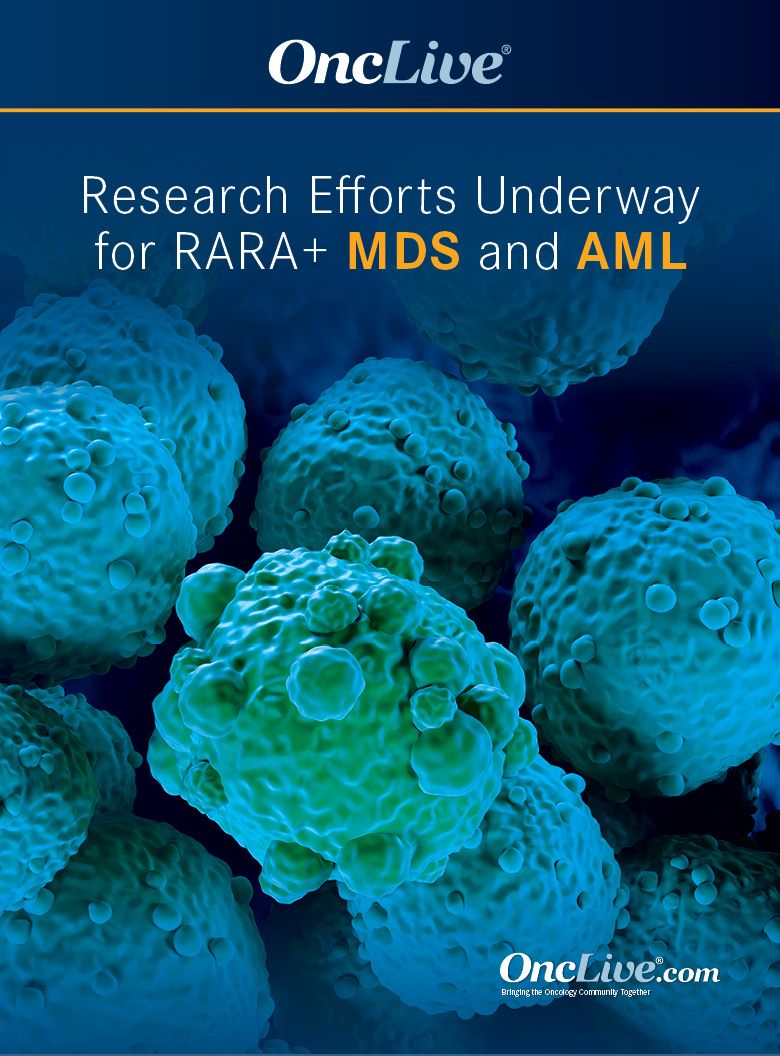Tamibarotene/Azacitidine Combination Under Investigation in Higher-risk MDS
Ana Alfonso Piérola, MD, PhD, discusses the rationale for targeting retinoic acid receptor alpha in patients with higher-risk myelodysplastic syndrome, the goals of the SELECT MDS-1 trial investigating tamibarotene, and where the future of research and treatment for this patient population is headed.
Image Credit: ©immimagery / Adobe Stock Images

The combination of tamibarotene (formerly SY-1425) and azacitidine (Vidaza) represents a potentially effective and tolerable addition to the higher-risk myelodysplastic syndrome (MDS) treatment armamentarium, according to Ana Alfonso Piérola, MD, PhD.
The phase 3 SELECT MDS-1 trial (NCT04797780) is currently enrolling patients with newly diagnosed, retinoic acid receptor alpha (RARA)–positive, higher-risk MDS. Patients will be randomly assigned to receive either the RARA agonist tamibarotene or placebo plus azacitidine. This trial has a primary end point of complete response (CR) rate, with secondary end points including overall response rate (ORR), event-free survival, overall survival (OS), and transfusion independence.1
The rationale to combine azacitidine and tamibarotene in SELECT MDS-1 was supported by findings from the phase 2 SY-1425-201 trial (NCT02807558), which assessed the efficacy and safety of the combination in patients with MDS or acute myeloid leukemia (AML). In the AML portion of this trial, the combination had a safety profile consistent with safety data previously reported with azacitidine monotherapy, with common adverse effects (AEs) including decreased appetite, hypertriglyceridemia, nausea, constipation, fatigue, and peripheral edema.2,3
“We will hopefully have some drugs approved in the next [few] years [for patients with higher-risk MDS], and [that will be] good news in the field, because it’s been difficult to have negative trial results,” Alfonso Piérola said.
In an interview with OncLive®, Alfonso Piérola discussed the rationale for targeting RARA in patients with higher-risk MDS, the goals of the SELECT MDS-1 trial, and where the future of MDS research and treatment is headed.
Alfonso Piérola is a specialist in the Department of Hematology and an associate clinical professor in the Faculty of Medicine at Clínica Universidad de Navarra in Pamplona, Spain.
OncLive®: What emerging therapies in MDS are important to note?
Alfonso Piérola: MDS is a heterogenous disease. We separate it into 2 types of disease: lower-risk MDS and higher-risk MDS. [Higher-risk MDS often] appears [in patients who are] around 70 years old. It’s an [older] patient disease, and that makes it hard to treat, because we also face problems with AEs.
Apart from that, we have 1 drug approved in Europe, azacitidine, [for patients with] higher-risk MDS. That was approved around 15 years ago, and we haven’t had any other drug approved since. We have had some bad news in the field because most of the drugs in phase 3 trials did not show any benefit, probably [because of] the heterogeneity of the patients who were included, and because [these agents gave] some patients more toxicities than benefits.
Now, we are facing something different. We are excited for results from phase 3 trials that include different types of drugs, [including] immunotherapy, tamibarotene, and venetoclax [Venclexta]. Three of [these trials] are finished, and then we have [SELECT MDS-1] that is enrolling patients now. This is the scenario we are facing now. We are expecting results, and we will see [them in future] meetings.
What is the rationale for using tamibarotene to target RARA in patients with higher-risk MDS?
This is not [a new concept] in the myeloid field. Around 50% of patients with higher-risk MDS overexpress RARA. This alpha receptor is a ligand regulator, a regulated nuclear receptor that acts as a transcriptional switch for myeloid differentiation. It also plays a role in stem cell self-renewal and blast proliferation. When the receptor is bound by its ligand, that stimulates the transcription and differentiation.
The overexpression of RARA inhibits differentiation and induces myeloid progenitor immortalization. Tamibarotene binds to the receptor and restores the differentiation of the cells. Results [from the SY-1425-201 trial] combining azacitidine and tamibarotene showed an increase in the reduction of blasts, and this is why [SELECT MDS-1 is] combining both drugs.
What key data were seen in patients with AML in SY-1425-201, and how do these findings support further investigation of this combination in patients with higher-risk MDS in SELECT-MDS 1?
The phase 2 trial included patients with AML who were unfit for intensive chemotherapy [and were] positive or negative for RARA overexpression. We have some results with that population. The median age at diagnosis was [74] years, and the safety data were nice, because it seems that tamibarotene does not induce any additional AEs or toxicities [beyond those seen with] azacitidine. [Tamibarotene] did not add any myelosuppression. This is important in this type of treatment.
Regarding efficacy, the results were separated by RARA-positive or RARA-negative patients. The ORR in the RARA-positive patients was 67%, and in the RARA-negative [patients, it] was 39%. Sixty-one percent of the patients in the RARA-positive [arm achieved] a CR. The population is small because 51 patients were included in the trial. However, it seemed that responses were not related to cytogenetics or molecular alterations, but to the overexpression of RARA.
Regarding OS, in the RARA-positive patients who achieved a CR, the median OS was 18 months. We are facing [a median OS of] around 12 months with azacitidine monotherapy.
[Tamibarotene] did not add any big problems regarding AEs, and it seems to [induce] more CRs and prolong the duration of CR, which ends in better OS. In this population of [older] patients who were not eligible for intensive chemotherapy, the results were impressive.
What is the rationale for the SELECT MDS-1 trial, and what patient population does this study aim to enroll?
This trial is including patients with higher-risk MDS with more than 5% blasts in the bone marrow, who are positive for RARA overexpression. The patients [will be] randomly assigned 2:1 to receive either azacitidine at 75 mg/m2 on days 1 through 7 [of each cycle] plus placebo or tamibarotene. [This trial is expected to enroll] around 190 patients. The principal objective is CR rate.
The trial is recruiting well. In Spain, at least 6 centers are open from the Spanish MDS Group, and [we] are recruiting quickly. We don’t have any other competitive [MDS] trials now, because the other [phase 3 studies] are finished [enrolling]. We will have some results [for SELECT MDS-1] next year, and we are excited.
In my experience, patients are tolerating [tamibarotene] properly. This is a blinded study, so I don’t know if my patients have received placebo or tamibarotene, but both [arms are experiencing] the trial [similarly], and I’m not seeing a big difference between them. We are not facing any different AEs, so hopefully we will have the results back soon.
What other unmet needs in MDS could future clinical trials address?
MDS is heterogenous, but the patients are also heterogenous. The objectives in different patients are completely different. This is a disease of [older] patients, but we have also some young patients who go to allogeneic stem cell transplant. Those patients probably need a drug that [can help them] achieve responses early.
The big point is CR. But we also have the [older] population [in which, in] my point of view, CRs are important because they end in a better quality of life for those patients. [However, another] big point is the duration of the response. It doesn’t make sense to have high rates of CR without [durable responses].
First, we need to design trials differently. Then, [we need to determine] what to do with patients who are refractory to hypomethylating agents [HMAs]. We are putting a lot of effort into improving results in the first line. That is important for those patients. However, we don’t have many trials studying the relapsed/refractory setting. That is disappointing. Hopefully, we will have some trials there and some drugs that can [benefit] that population. HMAS are the backbone of all the combination trials, but after HMAs, the OS is quite short, around 4 to 6 months. One unmet need now is in the first-line setting, but [there are also unmet needs in] the relapsed/refractory setting.
What overall message would you like colleagues to know about tamibarotene and the SELECT MDS-1 trial?
[Tamibarotene is] a targeted therapy that is interesting in this setting. We are exploring several targeted therapies now, [and since] the population [is heterogenous], that can work. [Tamibarotene is associated with] low added AEs [when combined with] azacitidine, and in an [older] population, that is important. [This agent has also generated] interesting response rates [in patients with AML]. A 67% ORR is a good number with 18 months of OS in those who responded. We need to see what happens in MDS, but they are interesting results. We are excited to [potentially] have a targeted therapy in MDS.
References
- Tamibarotene plus azacitidine in participants with newly diagnosed RARA-positive higher-risk myelodysplastic syndrome. ClinicalTrials.gov. Updated April 21, 2023. Accessed April 30, 2023. https://clinicaltrials.gov/ct2/show/NCT04797780
- De Botton S, Cluzeau T, Vigil CE, et al. SY-1425, a potent and selective RARα agonist, in combination with azacitidine demonstrates a high complete response rate and a rapid onset of response in RARA-positive newly diagnosed unfit acute myeloid leukemia. Blood. 2020;136(suppl 1):4-5. doi:10.1182/blood-2020-134600
- Syros presents new data from phase 2 clinical trial of SY-1425 and announces plans to initiate registration-enabling trial in MDS and randomized phase 2 trial in AML. News release. Syros. December 5, 2020. Accessed May 2, 2023. https://ir.syros.com/press-releases/detail/205/syros-presents-new-data-from-phase-2-clinical-trial-of




